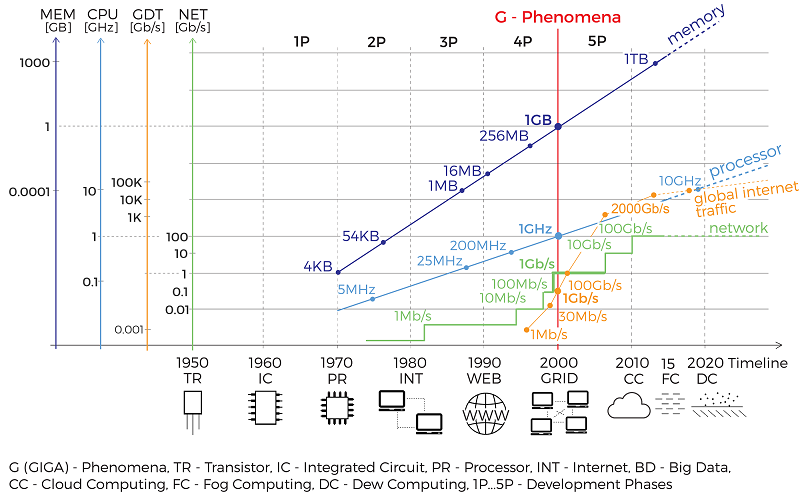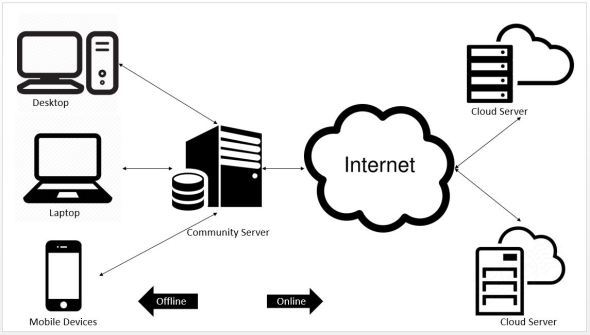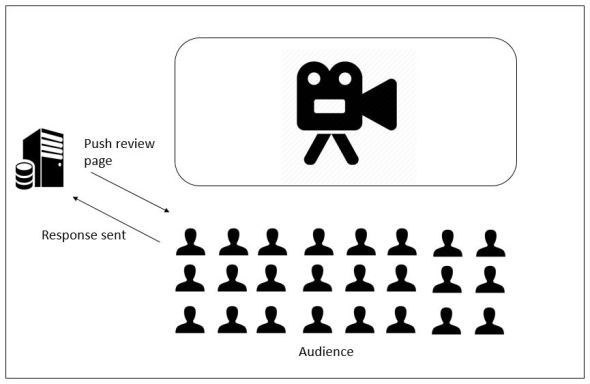Distributed computing architecture: from cloud to fog and dew
Independent computing that is compatible with cloud computing is called dewy (sorry, Habr, but we did not find another good definition of Dew Computing). The basic principle of dewy computing is that they fill the main drawback of cloud computing — a requirement for a stable 
Introduction
Cloud computing, one of the major computer and network events, is considered the most flexible and cost-effective solution to many problems. Among the limitations of cloud computing, there is a high latency, which is considered a big barrier to time-critical applications. Most IoT applications are sensitive to delays and require quick response. To this end, Cisco has introduced a new paradigm, hazy calculations. In foggy computing, the service can be hosted on the end device, access points, or a dedicated server.
A new type of computation allowed applications to work as close as possible to devices that generate a huge amount of data or processes that produce data. Foggy computing solves the problem of cloud latency. However, there remains another equally important issue - the requirement of a permanent connection to the Internet. This led to the invention of another kind of computational architecture, dewy computations, where a lightweight local copy is stored on the local device, which facilitates the work of the user, even offline. As soon as the
')
A good example is Dropbox or Google Drive for the desktop. The disk is always available, the user can save, update or delete data regardless of internet connection. 
Hierarchy of distributed computing
So, there is a new hierarchical structure consisting of three levels: cloudy, foggy and dewy calculations. These hierarchical layers are designed to facilitate the rapidly evolving complex distributed computer systems and must meet the following requirements:
- Performance: optimized for quick response, low latency processing;
- Availability: require redundancy, quick recovery in case of system failures;
- Reliability: the system must be reliable in terms of data and operation;
- Manageability: a scalable system that should be easy to use;
- Cost: includes the cost of hardware and software, but it is also important to consider other aspects necessary for the deployment and support of a scalable computing system.
Device Level Architecture
The above picture shows three layers: a user layer, a community layer, and a cloud layer. The user layer consists of user devices (personal computers, laptops, or mobile devices). Laptop and mobile devices are connected to the community server via wireless interfaces. The desktop can be connected to the community server via a serial interface or a wireless interface. At the same time, there is no need to actively connect to the Internet on the user's devices, and they are connected to the community server via the interface, A with

The end user devices will contain two isolated areas, data and control. These are closed infrastructures, completely independent of the operating system. The community server can access the public part of the device, take or download data from the data area, while control instructions (if any) are communicated using the control zone. The program or instruction set will control the behavior of the data in the data area. The user can choose what will be considered public, and also can put on his own management program.

Application level on the example of a movie rating system
Although the review system discussed below may be applicable to huge sets of

As soon as a person comes to the cinema, he connects to the open access community server. The community server launches an interactive page in the open data area on the user's device. Then a notification is sent to control the device, which will be shown to the user, for example, “Welcome! Please rate the movie. ” This kind of notification can be sent in between and at the end of the movie.
Whenever the user wants it, during the break or at the end of the film, he can evaluate and review the film, and the answer will be sent to the community server. All responses will be collected and sent via the Internet to the server. Such comments will be immediately available via the Internet, it completely solves the problem of consistency in the architecture of the dewy cloud. Also, instead of clicking on a specific page, a user can use Facebook or Twitter to get new feedback, but again, applications must be developed to support such an architecture. We will talk more about which applications can be developed to support such an architecture.
Application Level Architecture
We will discuss two scenarios that allow us to better demonstrate the concept.
Dropbox : With Internet access, Dropbox is functioning normally. When an internet connection is available, you can store, delete or update files.
When the Internet becomes available, the latest version of the file is saved, not the intermediate versions. And what if the user needs an intermediate option? To embed dewy computations, Dropbox can embed a version control system that will run locally on a user's device without an internet connection. As soon as a connection appears, the latest and intermediate versions saved using version control will be saved in the cloud.
Facebook mobile app : back to the movie scorecard example. As soon as the user enters the online cinema, the community server sends instructions for managing the Facebook interaction zone. It will then move a copy of the official movie page on Facebook to the data zone. The control zone connects the resulting movie page to Facebook and the Facebook application data. The user will not know that there is a separate page in front of him, he will leave a review about the movie on his Facebook page, the answers will be sent back to the community server, where they will get ratings / reviews, which are then synchronized with the Facebook server. Reviews / ratings will be available immediately on the Internet.
Instead of conclusion
With the introduction of the level of foggy calculations, inconsistency problems are solved to some extent. Operating systems and applications can support delicate computing using device and application tiers, respectively. Of course, the community server plays a crucial role in achieving completely autonomous computing.
Source: https://habr.com/ru/post/307058/
All Articles